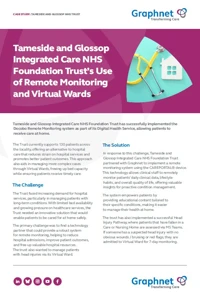Tameside and Glossop Integrated Care NHS Foundation Trust’s Use of Remote Monitoring and Virtual Wards
31 October 2024
Tameside and Glossop Integrated Care NHS Foundation Trust has successfully implemented the Graphnet Remote Monitoring system as part of its' Digital Health Service, allowing patients to receive care at home.
The Trust currently supports 130 patients across the locality, offering an alternative to hospital care that reduces strain on hospital services and promotes better patient outcomes. This approach also aids in managing more complex cases through Virtual Wards, freeing up bed capacity while ensuring patients receive timely care.
The Challenge
The Trust faced increasing demand for hospital services, particularly in managing patients with long-term conditions. With limited bed availability and growing pressure on healthcare services, the Trust needed an innovative solution that would enable patients to be cared for at home safely.
The primary challenge was to find a technology partner that could provide a robust system for remote monitoring, helping to reduce hospital admissions, improve patient outcomes, and free up valuable hospital resources. The trust also wanted to manage patients with head injuries via its Virtual Ward.
The Solution
In response to this challenge, Tameside and Glossop Integrated Care NHS Foundation Trust partnered with Graphnet to implement a remote monitoring system using the CAREPORTAL® device. This technology allows clinical staff to remotely monitor patients' daily clinical data, lifestyle habits, and overall quality of life, offering valuable insights for proactive condition management.
The system also empowers patients by providing educational content tailored to their specific conditions, enhancing their ability to manage their health at home.
The trust has also implemented a successful Head Injury Pathway, where patients that have fallen in a Care or Nursing Home are assessed via MS Teams. If someone with a suspected Head Injury with no obvious wounds / bruising or red flags, the patient is admitted to Virtual ward for 7-day monitoring. If the patient is on any antiplatelet Medication Patient, patient monitored up to 4 times per day, with a screening tool used to help mitigate risk.
Implementation
The implementation of the Docobo Remote Monitoring platform was a collaborative effort between the Trust’s Digital Health Centre and local council teams. This partnership enabled a swift deployment, from the initial kick-off meeting to full operation within just 14 days. The council team played a crucial role by assisting with device installations and training patients in the use of CAREPORTAL® devices. Over the past four years, the system has consistently delivered positive outcomes in patient care and operational efficiency.
Stats
- The Virtual Ward equates to 31,135 Bed Days Saved*. This is equivalent to 85 beds being free for 365 days and based on step up patients who were deflected away from ED/ Acute wards
- There was a 26% reduction in ‘no criteria to reside’
- From April 23 to December 2023, there were 2,299 Virtual Ward admissions.
- There were 327 head injuries that did not attend ED managed via the virtual ward. This means a VW Notional Savings of £114,450, excluding the cost of any Radiology.
*Based on figures from January 2023 to January 2024
Outcomes
The remote monitoring solution has enabled the Trust to achieve several significant outcomes:
- Remote Patient Monitoring: 130 patients are being monitored at home, preventing unnecessary hospital admissions and alleviating pressure on the healthcare system.
- Expansion of Virtual Wards: The Trust procured an additional 90 CAREPORTAL® devices, allowing the creation of Virtual Wards that support more complex patients at home and facilitate early discharges from hospitals.
- Increased Bed Capacity: By reducing bed occupancy and supporting timely hospital discharges, Virtual Wards have saved approximately 31,135 bed days, equivalent to 85 hospital beds being available for a full year.
- Cost Savings: Managing 327 head injuries via the Virtual Wards, without an ED visit, saved an estimated £114,450, excluding radiology costs.
- Reduced Emergency Department (ED) Attendance: There has been a 26% reduction in cases where patients had no criteria to reside in hospitals, further decreasing hospital admissions and promoting more efficient healthcare delivery.
Peter Grace, Deputy Director ITS & Clinical Nurse Lead for Digital Health at Tameside and Glossop says:
The ability to monitor and manage more complex patients at home has transformed how we deliver care. It also allows for early hospital discharges, ensuring that beds are available for those who need them most.
Zena Greenhalgh, Matron of the Digital Service at Tameside and Glossop Integrated Care NHS Foundation Trust says:
This service doesn’t only facilitate daily discharge and bed saving days, it facilitates better patient outcomes. Patients are back home; they have access to healthcare professionals seven days a week, they can pick up the phone and speak to a member of staff who will make sure they are ok. I had a patient who had a chest drain in situ, and she was in hospital for four weeks being monitored. Rather than staying in hospital even longer, we were able to get her back home and monitor her from there. That’s the beauty of this service. She was back in her own bed with her own family and her own surroundings, all whilst being closely monitored by the team.
Futures
The Trust is continually looking to evolve its use of remote monitoring and Virtual Wards.
Future goals include:
- Expanding support for Virtual Wards by identifying GP champions and increasing referrals from general practice.
- Promoting the value of Virtual Wards across clinical forums to foster broader adoption.
- Leveraging further technological developments to enhance the care pathways.
- Striving for incremental progress, embracing challenges with resilience, and remaining committed to ensuring the success of these innovative care models.
Tameside and Glossop Integrated Care NHS Foundation Trust’s partnership with Graphnet has transformed how patients are cared for through the use of Virtual Wards. By combining cutting-edge remote monitoring technology with proactive care pathways such as the Head Injury Pathway, the Trust has enhanced patient outcomes, reduced hospital admissions, and created much-needed capacity in the healthcare system. This approach continues to serve as a model for future digital health initiatives.










